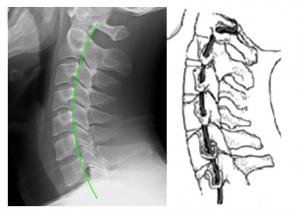Neck Pain

The Result of Poor Alignment
If phrases like “My back is out” or “I’ve got a crick in my neck” hit close to home, your spine might be sending you an SOS. Welcome to the world of spinal kinesiopathology – a fancy term for when your spine isn’t moving or aligning as it should.
Think of your spine as the freeway of your nervous system; when it’s out of alignment, your body can’t run smoothly. Whether it’s “text neck” from too much phone time or the aftermath of an awkward lift, poor alignment can ripple through your body, causing everything from headaches to fatigue.
Give your spine some TLC – it’s been holding you up for years!

Loss of Neck Curve Reduces Blood Flow to the Brain
Blood flow to the Brain is affected by the curve in your Neck
Decreased Vertebral Artery Haemodynamics in Patients with Loss of Cervical Lordosis.
An interesting study by Bulut MD et. al. 2016 of relevance to virtually all patients who visit a chiropractor shows a correlation between the curve in your neck and blood flow to the brain.
That is right – the correct curve in your neck allows the blood to flow to your brain in an optimal fashion.

Decreased Neck Muscle strength in patients with the loss of Cervical Lordosis
PUBLISHED: Clin Biomech (Bristol, Avon). 2016 Mar;33:98-102. doi: 10.1016/j.clinbiomech.2016.02.014. Epub 2016 Feb 27.
Referenced in Pub Med: https://www.ncbi.nlm.nih.gov/pubmed/26970701
AUTHORS: Alpayci M, Şenköy E, Delen V, Şah V, Yazmalar L, Erden M, Toprak M, Kaplan Ş.
CONCLUSIONS: According to our results, patients with the loss of cervical lordosis have reduced neck muscle strength, especially in the extensors.

Correlation between Cervical Lordosis and Cervical Disc Herniation in young patients with Neck Pain
PUBLISHED: Medicine (Baltimore). 2019 Aug;98(31):e16545. doi: 10.1097/MD.0000000000016545. PubMed: https://www.ncbi.nlm.nih.gov/pubmed/31374017
AUTHORS: Gao K, Zhang J, Lai J, Liu W, Lyu H, Wu Y, Lin Z, Cao Y.
RESULTS: The degree of disc herniation was higher in the straight and kyphosis groups compared to the lordosis group.
With the improvement of cervical lordotic curvature, the degree of disc herniation decreased and height of disc space increased.
CONCLUSIONS: The degree of disc herniation and cervical spinal cord compression are inversely correlated to cervical lordosis in young neck pain patients, and the degree of disc herniation and height of disc space can recover with the recovery of cervical lordotic curvature.

Does improvement towards a normal Cervical Sagittal configuration aid in the management of Cervical Myofascial Pain Syndrome
PUBLISHED: BMC Musculoskelet Disord. 2018 Nov 12;19(1):396. doi: 10.1186/s12891-018-2317-y. Pub Med: https://www.ncbi.nlm.nih.gov/pubmed/30419868
AUTHORS: Moustafa IM, Diab AA, Hegazy F, Harrison DE.
CONCLUSION: The addition of the denneroll cervical orthotic to a multimodal program positively affected chronic myofascial cervical pain syndrome (CMCPS) outcomes at long term follow up.

Prospective, Randomised, Double-Blind Clinical Study evaluating the correlation of Clinical Outcomes and Cervical Sagittal Alignment
PUBLISHED: Neurosurgery. 2011 May;68(5):1309-16; discussion 1316. doi: 10.1227/NEU.0b013e31820b51f3. PUB MED: https://www.ncbi.nlm.nih.gov/pubmed/21792113
AUTHORS: Villavicencio AT, Babuska JM, Ashton A, Busch E, Roeca C, Nelson EL, Mason A, Burneikiene S.
RESULTS: Patients who had maintained or improved segmental sagittal alignment, regardless of graft type, achieved a higher degree of improvement in Short Form-36 Physical Component Summary and Neck Disability Index scores. This was statistically significant (P < .038).
CONCLUSION: Maintaining a consistent segmental sagittal alignment or increasing segmental lordosis was related to a higher degree of improvement in clinical outcomes.
Spinal Centre Note: Appears surgeons are picking up what Chiropractic BioPhysics practitioners have been talking about. Well done.





